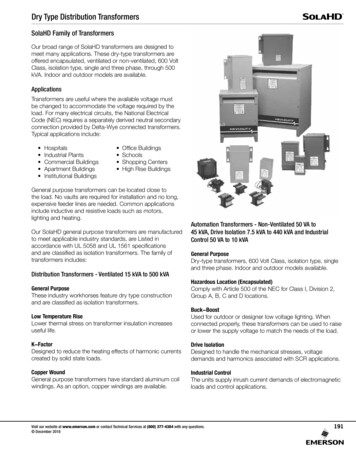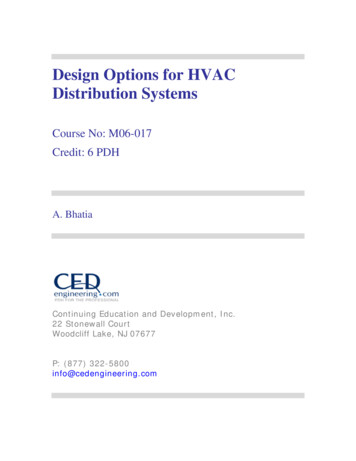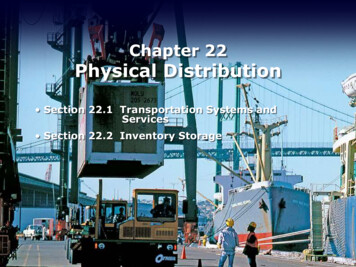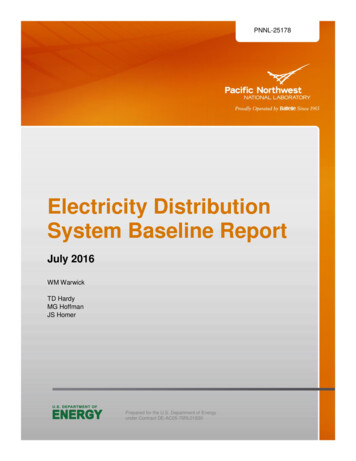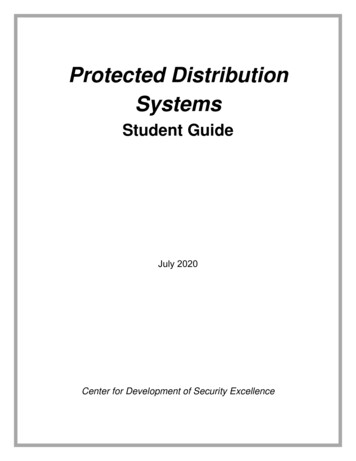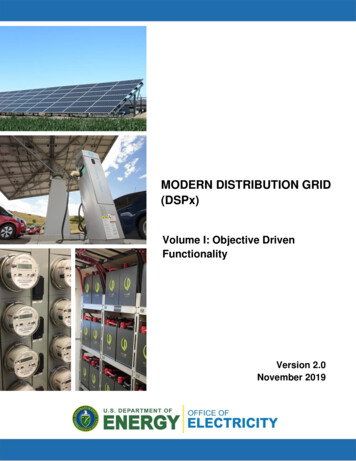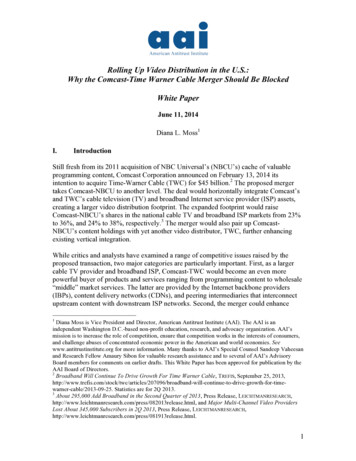
Transcription
Rolling Up Video Distribution in the U.S.:Why the Comcast-Time Warner Cable Merger Should Be BlockedWhite PaperJune 11, 2014Diana L. Moss1I.IntroductionStill fresh from its 2011 acquisition of NBC Universal’s (NBCU’s) cache of valuableprogramming content, Comcast Corporation announced on February 13, 2014 itsintention to acquire Time-Warner Cable (TWC) for 45 billion.2 The proposed mergertakes Comcast-NBCU to another level. The deal would horizontally integrate Comcast’sand TWC’s cable television (TV) and broadband Internet service provider (ISP) assets,creating a larger video distribution footprint. The expanded footprint would raiseComcast-NBCU’s shares in the national cable TV and broadband ISP markets from 23%to 36%, and 24% to 38%, respectively.3 The merger would also pair up ComcastNBCU’s content holdings with yet another video distributor, TWC, further enhancingexisting vertical integration.While critics and analysts have examined a range of competitive issues raised by theproposed transaction, two major categories are particularly important. First, as a largercable TV provider and broadband ISP, Comcast-TWC would become an even morepowerful buyer of products and services ranging from programming content to wholesale“middle” market services. The latter are provided by the Internet backbone providers(IBPs), content delivery networks (CDNs), and peering intermediaries that interconnectupstream content with downstream ISP networks. Second, the merger could enhance1Diana Moss is Vice President and Director, American Antitrust Institute (AAI). The AAI is anindependent Washington D.C.-based non-profit education, research, and advocacy organization. AAI’smission is to increase the role of competition, ensure that competition works in the interests of consumers,and challenge abuses of concentrated economic power in the American and world economies. Seewww.antitrustinstitute.org for more information. Many thanks to AAI’s Special Counsel Sandeep Vaheesanand Research Fellow Amaury Sibon for valuable research assistance and to several of AAI’s AdvisoryBoard members for comments on earlier drafts. This White Paper has been approved for publication by theAAI Board of Directors.2Broadband Will Continue To Drive Growth For Time Warner Cable, TREFIS, September 25, ewarner-cable/2013-09-25. Statistics are for 2Q 2013.3About 295,000 Add Broadband in the Second Quarter of 2013, Press Release, /press/082013release.html, and Major Multi-Channel Video ProvidersLost About 345,000 Subscribers in 2Q 2013, Press Release, /press/081913release.html.1
Comcast-TWC’s ability and/or incentive to potentially engage in exclusionary conduct.By virtue of an enlarged video distribution footprint, Comcast-TWC could serve as a“gatekeeper,” i.e., to control what rival content reaches its subscribers. Moreover, bypairing Comcast-NBCU content with TWC distribution, the merged company couldexercise more control over whether its own content reaches rival multi-videoprogramming distributors (MVPDs) and online video distributors (OVDs).All told, the combination would grant Comcast-TWC a vast measure of economic controlover whether, what, how, and when important news, opinions, sports, and entertainmentvideo programming is delivered to tens of millions of Americans. This landscape raisesthe troubling prospect of spillover effects from more concentrated economic power toexpanded political control and diminished diversity and independence in the media.Comcast-TWC comes at a time when the industry is grappling with fundamental policyquestions about an open Internet, the answers to which could well be shaped by theproposed merger. Moreover, the American consumer appears to be particularly unhappywith the merging parties’ cable TV and ISP products and services.The Comcast-TWC deal raises potentially significant competitive issues, little or nooffsetting cost savings or consumer benefits, and would be extraordinarily difficult to“fix” with either structural or behavioral remedies. While Comcast describes itself as the“perfect partner” for TWC, the merger is nevertheless a poor match for competition andconsumers.4 In light of these concerns, the interests of consumers might be better servedif the U.S. Department of Justice (DOJ) and Federal Communications Commission(FCC) took a step back to contemplate the sea-change the deal would imply for the cableTV and broadband ISP industry. Adding in AT&T’s bid for DirecTV, and the widelypredicted transaction between Sprint and T-Mobile, makes the case for why competitionauthorities should consider a “go slow” policy for the next two years, or even a temporarymoratorium on such mega-deals. At the very least, these various transactions should notbe viewed as if each were an isolated event. Rather, industry-wide dynamics andoverarching policy goals should factor prominently into an enforcement framework.This White Paper explores what the American Antitrust Institute (AAI) believes to be themajor competitive issues raised by the proposed merger and why it should be blocked. Incontrast to the DOJ and FCC, which have access to proprietary data, AAI’s analysis isbased on public data and information and our conclusions are limited accordingly. Thepaper proceeds as follows. Section II provides background on Comcast’s historicalexpansion through mergers and acquisitions. Section III sketches out the importantbackdrop for evaluating the proposed merger, namely the trend toward mega-deals, ahistory of swaps involving the parties, and their relatively poor performance. Section IVevaluates two major competitive issues raised by the proposed merger, namely how themerger could enhance the ability and/or incentive for a combined Comcast-TWC topotentially exercise buyer market power and engage in exclusionary conduct with regardto rivals. Section V analyzes Comcast-TWC’s efficiencies claims. Section VI discusses4Investor Presentation, Comcast and Time Warner Cable, February 13, 2014 (at ff9/Comcast%20Investor%20Presentation.pdf.2
the inadequacy of approving the proposed deal with remedies, particularly any proposalto graft the behavioral fixes imposed in Comcast-NBCU onto the Comcast-TWCtransaction. Section VII concludes.II.Comcast’s Growth Through M&AComcast is the largest cable operator in the U.S., with approximately 22 million cabletelevision subscribers and 21 million broadband residential and business customers.5 Thecompany also provides voice services to almost 11 million customers.6 TWC has about11 million cable television subscribers, almost 12 million broadband customers, andserves about 5 million voice customers.7 Together, the combined company would haveabout 36% of the national cable TV market and about 38% of the national broadbandmarket.8 With an existing presence in 31 Nielsen “designated market areas” (DMAs),Comcast would expand through the acquisition of TWC to cover 15 additional DMAs, 12of which are in markets in which Comcast does not currently operate.9 Once merged, thecombined company will have a presence in 92% of the 25 top DMAs, and 86% of the top50 DMAs.As shown in Figure 1, Comcast has grown significantly over the last 20 years through aseries of major mergers and acquisitions of cable programming providers and videodistributors. Comcast has expanded the geographic scope of its distribution operations byacquiring: Maclean Hunter (1994), Lenfest Communications (1999), and AT&TBroadband (2002). Some of Comcast’s major content programming acquisitions include:the Golf Channel (1994), E! Entertainment (1997), and Outdoor Life Network (nowNBCSN, 2001). Comcast currently has a controlling interest in eleven regional sportsnetworks (RSNs), including networks in the Bay Area, Chicago, and Washington, D.C.5In the Matter of Applications of Comcast Corp. and Time Warner Cable Inc. for Consent to TransferControl of Licenses and Authorizations (Application), MB Docket No.14-57, before the FederalCommunications Commission (April 8, 2014), at 8-9.6Id. at 10.7Id. at 14-15.8Supra note 3.9Investor Presentation, supra note 4. “DMA regions are the geographic areas in the United States in whichlocal television viewing is measured by The Nielsen Company. The DMA data are essential for anymarketer, researcher, or organization seeking to utilize standardized geographic areas within theirbusiness.” See DMA Regions, NIELSEN, ml.3
Figure 1: The Growth of ComcastTen RSNs intotal todayCONTENTGolf DBAND(DISTRIBUTION)19931995Adelphia(split assetswith TimeWarner)LenfestMacleanHunterNBC Universal:NBC, USA, Bravo,CNBC, ?VerizonPartnership20052007200920112013In 2011, Comcast consummated its highest profile acquisition in the content area byacquiring a controlling stake in NBCU, the owner of, among others, NBC, USA, Bravo,and Universal Studios. In 2013, the company purchased General Electric’s minorityinterest and became the sole owner of NBCU.In contrast to Comcast’s expansion-through-acquisition evolution, TWC was spun off in2009 from film and television producer, and cable channel operator Time Warner. Inaddition to cable television and broadband distribution assets, TWC currently owns cableprogramming assets that include two RSNs in Los Angeles and interests in Sports NetNew York and Sports Net LA.III.The Merger in Context – The Trend Toward Mega-deals, a History of Swaps,and the Relatively Poor Performance of Comcast and TWCA.The Trend Toward Mega-DealsThe proposed merger is part of a swell of mega deals that now pepper the popularbusiness press on almost a daily basis. The Economist reported recently that in 2014,there have been 15 transactions worth more than 10 billion, the largest since the “M&Arush” of 2007.10 Valued at 69.8 billion, Comcast-TWC fits into the high end of therecent parade of mega mergers. The takeover of DirecTV by AT&T (valued at 48billion) will advance this trend.1110Return of the Big Deal, ECONOMIST, May 3, 2014, landscape-especially-europe.11Michael J. de la Merced, AT&T Said Near Deal to Buy DirecTV, N.Y. TIMES DEALBOOK, May 17, 2014,4
Annual reports to Congress by the DOJ and the Federal Trade Commission (FTC)indicate that since 2001, larger deals account for the biggest growth in transactionsreportable under the Hart-Scott-Rodino pre-merger filing requirements. For example, theaverage annual growth in deals under 50 million in value was about -5% from 2000 to2012. Deals between 100- 300 million grew at the rate of only 1.5% annually, whiledeals between 300- 500 grew at about 5% annually.12 The real growth was intransactions valued between 500 million and 1 billion, which grew at about 12% peryear over the period, and deals in excess of 1 billion grew at an annual rate of 6.5%.Mega deals such as Comcast-TWC highlight the troubling trend toward consolidation inmany important industries, including transportation, telecommunications, agriculture, andhealthcare.13 Despite claims of cost efficiencies, consumer benefits, and enhancedinvestment and innovation, the ability of merged companies to prove up the claimedbenefits is increasingly viewed with skepticism.14 Moreover, there is the real risk that“mergers-to-tighter-oligopoly” facilitate market structures that are conducive to tacitcoordination that drives up price, restricts output, eliminates choice, and stiflesinnovation.For example, the recently consummated merger of US Airways and American Airlinescompleted the transformation of the domestic passenger aviation industry into a tightoligopoly, potentially exacerbating the propensity of the few large carriers to coordinateon pricing and capacity decisions. A similar landscape is evolving in the cable TV andbroadband ISP industries, where major incumbents have swapped service territories tosolidify their dominance and mergers are creating larger conglomerate firms. Thesetrends make markets less permeable to entry by innovative firms and smaller rivals,eliminate potential competition, and increase the risk of strategic exclusionary conduct bydominant players.In the aftermath of the aborted AT&T-T-Mobile merger, the DOJ sent a warning shotacross the bow of consolidation. The New York Times reported as follows on a January2014 address by DOJ Deputy Attorney General William Baer to the New York /17/att-said-near-a-deal-for-directv/? php true& type blogs& r 0.12U.S. Department of Justice and Federal Trade Commission (F.T.C.), Annual Reports To CongressPursuant To The Hart-Scott-Rodino Antitrust Improvements Act Of 1976, 2000 through 2012, Table /annual-competition-reports.13Eduardo Porter, Concentrated Markets Take a Big Toll on Economy, N.Y. TIMES, May 28, 2014, at B1,available at ?src rechp& r 2.14See, e.g., Scott A. Christofferson, Robert S. McNish, and Diane L. Sias, Where Mergers Go Wrong,MCKINSEY ON FINANCE 2004, at 2-3, available id m0286.See also Diana L. Moss, Delivering theBenefits? Efficiencies and Airline Mergers, American Antitrust Institute, November 21, es-andairline-mergers.5
“It’s going to be hard for someone to make a persuasive case that reducingfour firms to three is actually going to improve competition for the benefitof American consumers,” he [Baer] said, without referring to any specificmerger proposal. “Any proposed transaction would get a very hard lookfrom the antitrust division.” Mr. Baer said that the division wouldsimilarly scrutinize any proposed merger among cable televisioncompanies.15A key question for many keystone U.S. industries where tight oligopolies nowexist is whether additional consolidation is permissible under the U.S. antitrustlaws.B.Dividing Markets and Solidifying Dominance Among VideoDistributorsThe broader trend toward mega-deals provides an important backdrop against which toconsider the Comcast-TWC (and AT&T-DirecTV) merger. Add to this mix the fact thatcable TV providers and broadband ISPs have a history of dividing up markets andsolidifying their dominance in market areas. For example, Comcast and TWC teamed upto acquire and divide the assets of bankrupt cable provider Adelphia Communications in2006. Later, they executed a series of swaps to consolidate and solidify each firm’spresence in several major DMAs in the current top 15, including Los Angeles (TWC),Philadelphia (Comcast), Houston (Comcast), Dallas (TWC), and the Twin Cities(Comcast).16Comcast and TWC, along with cable provider Bright House, also entered into a majorpartnership with Verizon in 2012. Comcast and its cable peers transferred spectrum toVerizon in exchange for the telecom giant’s pledge not to further expand its FiOS fiberoptic network. In exchange, the participants in the transaction agreed to market eachother’s wireless and wireline services.17 This widely criticized deal amounted essentiallyto market division, whereby cable providers abandoned any intentions of getting into thewireless business while Verizon halted its spending on entry into cable TV and fixed15Edward Wyatt, Wireless Mergers Will Draw Antitrust Scrutiny Says Antitrust Chief, N.Y. TIMESDEALBOOK, Jan. 30, 2014, rgers-will-draw-scrutinyantitrust-chief-says/? php true& type blogs& r 0 (quoting Remarks as Prepared for Delivery byAssistant Attorney General Bill Baer to the New York State Bar Association, Reflections on AntitrustEnforcement in the Obama Administration (Jan. 30, 2014), available 9.pdf).16Time Warner Cable and Comcast to Acquire Assets of Adelphia Communications; Companies Also toSwap Certain Cable Systems and Unwind Comcast’s Interests in Time Warner Cable and Time WarnerEntertainment, Press Release, Comcast Corp., COMCAST, April 21, 2005, available inme.17Azam Ahmed, Verizon Wireless Buys Spectrum for 3.6 Billion, N.Y. TIMES, Dec. 2, 2011, available 36-billion/.6
broadband.Yet another swap is on the horizon, subject to DOJ and FCC review, if the ComcastTWC deal goes through with the proffered divestiture of almost four million subscribers.Charter Communications will reportedly acquire divested subscribers and swapsubscribers with Comcast.18 This swap is being marketed as a boon to efficiency.Comcast Chief Executive Office Brian Roberts stated: “The realignment of key cablemarkets achieved in these transactions will enable Comcast to fill in our footprint anddeliver operational efficiencies and technology improvements.”19 If the proposed CharterComcast swap operates much like the swaps of 2006, Comcast could solidify itsdominance in regional geographic areas. While some swaps that promote cable clusteringmay enhance scale economies, those benefits may come at the risk of higherconcentration and higher prices to consumers. And to the extent swaps are contemplatedto implement market division, they are illegal under the U.S. antitrust laws.C.The Relatively Poor Performance of Comcast-TWC and U.S.BroadbandAnother important element of the landscape against which the Comcast-TWC mergershould be evaluated is how well the two companies have fared in the eyes of theconsumer. Comcast has grown primarily through mergers and acquisitions, as opposedorganic growth, and in the process has eliminated choices for consumers. This hasgarnered significant attention in the debate over Comcast-TWC. While part of a broaderarray of indicators of competitive vigor, consumer satisfaction rankings provideimportant insight. In a national survey by Consumers Union, for example, Comcastranked in the lowest 25th percentile for consumer satisfaction in pay TV and broadbandInternet service. TWC also performed badly – ranking in the bottom 30th percentile forsatisfaction.20 The 2013 American Customer Satisfaction Index (ACSI) rankings revealthat Comcast and TWC came in 8th and 9th (out of nine total companies), respectively, inconsumer satisfaction for pay TV. Comcast and TWC came in 7th and 8th (out of eightcompanies), respectively, for broadband Internet service.21Poor consumer satisfaction rankings stand oddly in contrast to Comcast-TWC’s claims inits FCC application that Comcast is the leading innovator in cable TV and broadband18David Gelles, Charter and Comcast to End Fight Over Time Warner Cable, N.Y. TIMES DEALBOOK,April 27, 2014, Id.20Telecom Services Ratings, CONSUMERREPORTS, available edservice-ratings/ratings-overview.htm. Ratings are based on Spring 2013 survey information.21Benchmarks for Comcast, Subscription Television Service Score Table, American Customer ?option com content&view article&id 149&catid &Itemid 214&c Comcast&i
merger could enhance the ability and/or incentive for a combined Comcast-TWC to potentially exercise buyer market power and engage in exclusionary conduct with regard to rivals. Section V analyzes Comcast-TWC’s efficiencies claims. Section VI discusses 4 Investor Presentation, Comcast and


